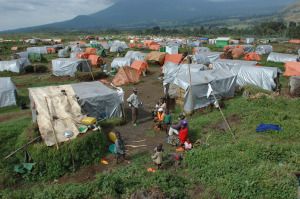Environmental Refugees to Plague the World
 According to the Office of the United Nations High Commissioner for Refugees (UNHCR) the number of refugees surged 10.5 million by the end of 2012. 25 percent of the global refugee population consisted of 2.6 million Afghan refugees, followed by Somalia’s (1.1 million), Iraq’s (746,000), Syria’s (729,000), Sudan’s (569,000), and refugees from the Democratic Republic of the Congo (509,300). Interestingly, most of the refugees, whom usually fled from developing countries, have taken shelter in Pakistan, which hosted 8.5 million refugees that year, or 81 percent of all global refugees. Among the top five host nations, Germany is the only first-world country.
According to the Office of the United Nations High Commissioner for Refugees (UNHCR) the number of refugees surged 10.5 million by the end of 2012. 25 percent of the global refugee population consisted of 2.6 million Afghan refugees, followed by Somalia’s (1.1 million), Iraq’s (746,000), Syria’s (729,000), Sudan’s (569,000), and refugees from the Democratic Republic of the Congo (509,300). Interestingly, most of the refugees, whom usually fled from developing countries, have taken shelter in Pakistan, which hosted 8.5 million refugees that year, or 81 percent of all global refugees. Among the top five host nations, Germany is the only first-world country.
Despite numerous effort to resolve the growing refugee problem, the international community struggles to cope with numbers of refugees that have peaked since the end of World War II. Antonio Guterres, the United Nations high commissioner for refugees, warned that “The international community needs to prepare their populations for the reality that in the absence of solutions to conflict, more and more people are going to need refuge and care in the coming months and years.” He added, “Unfortunately, it is not clear that the resources and the access to asylum will be available to help them.”
However, the future of the refugees does not seem very optimistic. A refugee, by the definition of UNHCR, is a person who is fleeing persecution due to “race, religion, nationality, membership of a particular social group or political opinion.” However, a new type of refugees emerged during the late 1900s, those who are now known as the environmental refugees.
The United Nations Environmental Programme (UNEP) defines environmental refugees as “those people who have been forced to leave their traditional habitat, temporarily or permanently, because of a marked environmental disruption (natural and/or triggered by people) that jeopardized their existence and/or seriously affected the quality of their life.” By ‘environmental disruption’, the agency includes “any physical, chemical and/or biological changes in the ecosystem (or the resource base) that render it temporarily or permanently unsuitable to support human life.” Climate refugees are also categorized under environmental refugees, and are those that have been forced to leave their homes and communities due to the effects of climate change and global warming.
The term “environmental refugee” began to be used as early as 1985. Yet, it was only within a decade that the environmental refugee became a growing concern, when people were forced to relocate due to rising sea levels and various natural disasters, namely volcanoes and tsunamis. The Maldives, a collection of islands in the Indian Ocean less than 6 feet above sea level, are likely to be the very first country to submerge entirely due to rising sea levels. Carteret Islands, a group of six atolls just off the northeast coast of Bougainville Island in Papua New Guinea, are also threatened by global warming. The urban area of Venice, Italy, is one of many cities that may go underwater.
The International Red Cross estimates that the number of environmental refugees outweighs that of political refugees fleeing from wars and violent conflicts. In 2011, at the annual meeting of the American Association for the Advancement of Science (AAAS), experts warned that there will be up to 50 million environmental refugees in 2020, according to UN estimates. A report by Washington D.C.-based Refugees International estimates that as many as 200 million people will be displaced by natural disasters and climate change by 2050.
Fortunately, the solution to the environmental refugee problem is fairly straight-forward: the international community must cooperate to eliminate the causes of global warming. Reducing the emission of greenhouse gas is an example of such efforts. At a time when the sea level has been rising at a rate of 0.14 inches (3.5 millimeters) per year since the early 1990s, and is estimated to rise a total of 7 inches to 2 feet (0.18 to 0.6 meters) between 1990 and 2100, the world must act to protect populated areas from sinking under the sea level. The countries that are especially responsible for large amount of greenhouse gas emission must be held accountable for the cause of environmental refugees. These nations may not immediately or directly influence the rise of sea level, but there are thousands of people’s lives threatened by it. Recklessness will lead to disaster. It is therefore the responsibility of concerned nations to put this type of recklessness in check.
Another concern with climate change is potential increase in the number of traditional refugees. Antonio Guterres noted, “Climate change can enhance the competition for resources – water, food, grazing lands – and that competition can trigger conflict.” Resource is limited, and hence we need to divide it effectively. If we are voluntarily destroying available resources, we will be inevitably encountering resource allocation problem sooner, at a time when we are most vulnerable.
To be or not to be - that is not the question. The status quo is no longer an option, and if we do not work now to prevent the worst, we will face the worst possible consequence. Refugees will constantly pose a problem for the international community. It is only through international cooperation that we will be able to it.
